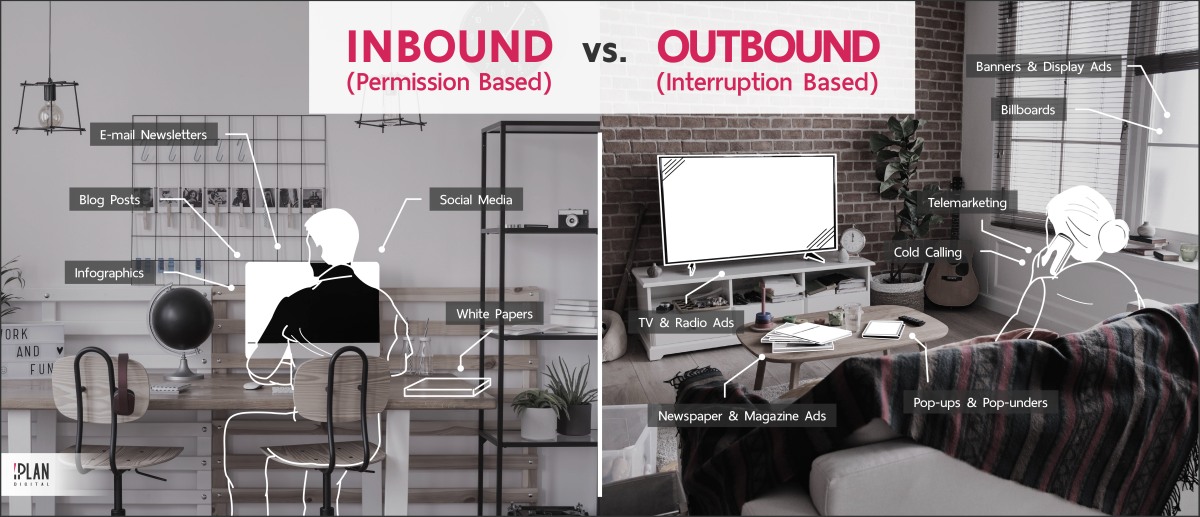2.Engage
3.Convert and Close
4.Delight
Inbound Marketing Strategy & Content
How do you successfully engage with modern customers? How do you get them to notice and interact with you without interrupting their flow and immediately turning them off?
Inbound marketing (for Thai version, please go here: Inbound Marketing) is one of the key methods for getting people interested in what you do and turning them into paying customers that will come back time and again.
Inbound Marketing
What Is Inbound Marketing?
Inbound marketing is a process, like many other marketing methods, that takes someone who is a complete stranger to your business services or products and helps you to make a sale. The key difference with inbound marketing is that the “complete stranger” isn’t actually a stranger at all – they know a lot about you already.
And in addition to other practices, inbound marketing includes a final “Delight” stage to ensure your customers are truly satisfied and primed to buy from you again.

Here is How Inbound Marketing Works:
A standard sales funnel or pipeline may be:
1.Build awareness
2.Generate interest
3.Convert and Close
Inbound marketing differs in the attraction/awareness stage, and that it is cyclical – once the customer is delighted, they’re attracted to more from your company.
Attract
Just as with any marketing process, the first step is to get people through the door – or rather, to get them to visit your website. Multiple strategies can be employed including ads, social media, content, blogging, videos, and so on.
The key is to create awareness, just as in a standard sales funnel, and by building awareness on a multitude of platforms with differing kinds of media, you’ll stand the greatest chance of reaching the most people.
By targeting ads at your desired demographic or creating content that appeals to the people you envisage as your ideal customer, you’ll attract those who are most likely to want to buy from you.
Attracting everyone possible is not the goal, nor is it the goal to make the world aware of what you are offering. You want the people who are interested in what you do, as the chances of converting them into paying customers are much higher.
Engage
By engaging with these visitors – who are now your prospects – you’ll begin to form relationships with them. For a prospect, a relationship with a brand is important, as it creates a lasting impression on them. Therefore, you need to ensure it’s a good impression!
Communicate with your prospects in the manner that best suits them, whether its chatbots, messaging apps, email, or anything else. Capture as much information from them as you can through on-site forms and calls to action and use CRM to make the journey through your site and content more personal.
Once you know that a visitor has a particular issue or problem they want to solve, it is much easier to build a relationship and convert them if the site is tailored to deliver content specific to their needs. Sending emails recommending solutions will bring more conversions than generic sales emails.
It is vital that you listen to what the prospect says and react accordingly – even if the process is entirely automated.
Convert and Close
Once the prospect has found their solution, they may spend some time considering their options. If they have built a solid relationship with you, it is likely that their decision will reflect this. They won’t buy from the faceless corporate entity (even if the price is better) but would rather make their purchase from a brand that they have grown to know and trust.
This trust is only developed by engaging with the prospects and building a real relationship.
Delight
The final stage of the inbound marketing process is to delight the customer. By continuing to work at the relationship (perhaps by sending emails that target the next problem you anticipate the customer will face, or alternatively giving hints and tips on the product or service they already have) you’ll stand the best chance of sending them back to the attract stage, perpetuating your sales process.
Remember, it’s easier to sell to an existing customer than it is to develop a prospect.
Why Inbound Marketing is Better
Inbound marketing works for the customer and is permission-based – they allow you to talk to them. This is contrary to traditional outbound marketing which is designed to interrupt what the prospect is doing, contacting them without permission. For example, cold calling and spam emails are examples of outbound marketing, and people are no longer prepared to respond positively to this kind of communication.
Outbound marketing is discovered when the prospect already has an idea of what they want or need and can be used to educate them about the possibilities. It’s almost like a recommendation from a friend, rather than being shouted at and told what is best for you.

